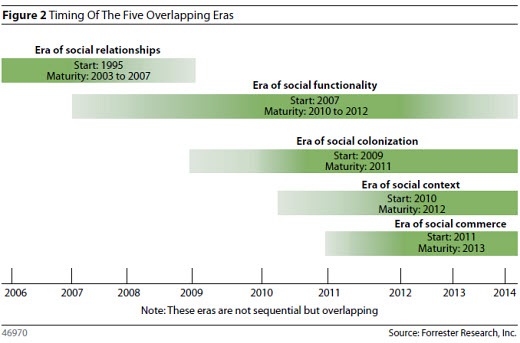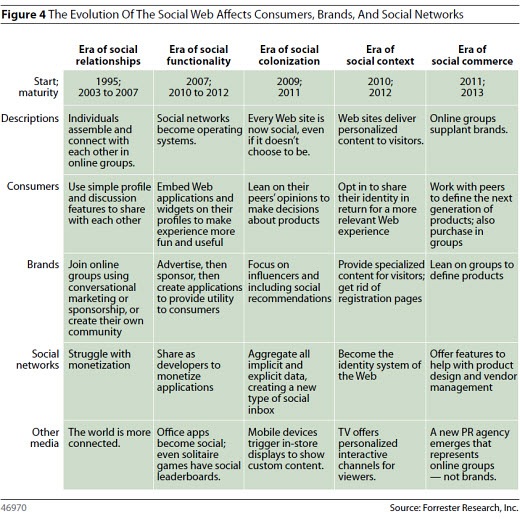
Brian Solis writes a thought-provoking post about how he sees the future of the social web, prompted by a Forrester report of the same name published in April.
Forrester’s research examined what’s happening in the context of what they describe as the five eras of the social web that began over a decade ago and continues through 2014. Their arguments on how the web is developing and evolving is nicely illustrated in this graphic from their report: how the five eras overlap and how the metamorphosis that’s happening is accelerating, driven by technology as a catalyst amid people’s rapidly-changing online behaviours.

Brian does a good job in summarizing the thrust of Forrester’s arguments, centred around portable identity or data portability as the prime catalyst for empowering consumers. His post makes some of the key aspects in Forrester’s report (which I read when it was published in April) a lot clearer.
Brian takes Forrester’s conclusion –
Today’s social experience is disjointed because consumers have separate identities in each social network they visit. A simple set of technologies that enable a portable identity will soon empower consumers to bring their identities with them — transforming marketing, eCommerce, CRM, and advertising. IDs are just the beginning of this transformation, in which the Web will evolve step by step from separate social sites into a shared social experience. Consumers will rely on their peers as they make online decisions, whether or not brands choose to participate. Socially connected consumers will strengthen communities and shift power away from brands and CRM systems; eventually this will result in empowered communities defining the next generation of products.
– and extends that view by introducing the notion of SRM: Social Relationship Management. He explains it thus:
[…] The Social Web is distributing influence beyond the customer landscape, allocating authority amongst stakeholders, prospects, advocates, decision makers, and peers. SRM recognizes that whether someone recommended a product, purchased a product, or simply recognized it publicly, in the end, each makes an impact on behavior at varying levels.
Therefore customers are now merely part of a larger equation that also balances vendors, experts, partners, and other authorities. In the realm of SRM, influence is distributed and it is recognizes wherever and however it takes shape.
Hmm, distributed influence as a concept, recognized as such wherever you see it. That idea is very interesting and one I find appealing, especially as you already see it happening even if it’s not referred to as such.
So Brian’s vision of the social web looks like it takes all of Forrester’s predictions that are summed up into the idea of the “socially-connected consumer” where technologies drive data portability, and extends it deeper and broader into the realm of people’s changing behaviours where, I believe, such changes in behaviours are the actual drivers behind events such as Forrester’s five overlapping eras.
To give you a better sense of where Forrester (and Brian Solis) see us going in the coming five years, here’s Forrester’s explanation of the three forward-looking eras they talk about, from now until 2013, described on page 2 of their report, followed by a picture of evolution described on page 6 of the report:
- 2009-2011: The era of social colonization. In the next stage of social evolution, starting later in 2009, technologies like OpenID and Facebook Connect will let individuals traverse the Internet with their social connections along for the ride. The boundaries of social networks and traditional sites will blur, making every Web site into a social experience.
- 2010-2012: The era of social context. Next year, as sites begin to recognize people’s personal identities and their social relationships, they will customize visitors’ experiences based on their preferences, their behaviors, and who their friends are. In addition to enabling more intense social applications, in this stage social networks will absorb features of email and become a base of operations for everyone’s online experiences.
- 2011-2013: The era of social commerce. Starting about two years from now, as social networks become the repository for identities and relationships, they will become more powerful than corporate Web sites and CRM systems. Communities will become the driving force for innovation. As a result, brands will cater to communities, resulting in a power shift toward the connected customer.

I summarize everything like this: It’s about people, not technology: how people behave online and the pivotal role social networks have on catalyzing behaviour change. Isn’t that actually what Forrester, Brian Solis and others are really saying in slightly different ways?
I include Twitter in that broad heading of social networks, incidentally: together with its ecosystem, it is a social network to many, and may become one of the most influential and change-making of all, far more than it is now.
What do you think? How do you see the future (the immediate one: within the next four to five years) of the social web?
Required reading:
- The Future of the Social Web – post by Brian Solis on October 30, 2009.
- The Future Of The Social Web – report by Forrester Research, published on April 27, 2009.
- The Future of the Social Web: In Five Eras – post by Jeremiah Owyang, primary author of the Forrester report, on April 27, 2009.
This post was originally published at NevilleHobson.com.
Get the TNW newsletter
Get the most important tech news in your inbox each week.




